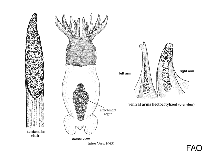Idiosepius kijimuna Reid, Sato, Jolly & Strugnell, 2023
Ryukyu pygmy squidتصوير گوگل | No image available for this species;
drawing shows typical species in Idiosepiidae.
رده بندی / Names اسامي عام | مترادف | CoL | ITIS | WoRMS
Cephalopoda | Sepiolida | Idiosepiidae
Environment: milieu / climate zone / تغييرات عمق / distribution range بوم شناسي
نزديك كف زي; تغييرات عمق 2 - ? m (مرجع 129526). Subtropical
Distribution كشورها | مناطق سازمان خوار و بار جهاني (FAO) | Ecosystems | ظهور | معرفي
Northwest Pacific: Japan.
Length at first maturity / Size / Weight / سن
بلوغ: Lm ? range ? - ? cm Max length : 0.8 cm ML جنس نر / بدون خواص جنسي; (مرجع 129526); 1.18 cm ML (female)
Life cycle and mating behavior بلوغ | تولید مثل | تخم ریزی | Eggs | Fecundity | Larvae
مآخذ اصلی
مراجع | هماهنگ كننده | همكاران
Reid, A., N. Sato, J. Jolly and J. Strugnell 2023 Two new pygmy squids, Idiosepius kijimuna n. sp. and Kodama jujutsu n. gen., n. sp. (Cephalopoda: Idiosepiidae) from the Ryukyu Islands, Japan. Mar. Biol. 170:167. (مرجع 129526)
وضعيت در فهرست قرمز IUCN
(مرجع 130435: Version 2025-1)
وضعيت از نظر سايتس (مرجع 108899)
CMS (مرجع 116361)
خطر برای انسان ها
استفاده انسانی
| FishSource |
ابزارها
اطلاعات بيشتر
تركيب غذايي
مصرف غذايي
شکارچیان
Max. ages / sizes
Length-weight rel.
Length-length rel.
نوسانات طولی
Mass conversion
فراواني
بلوغ
Fecundity
تخم ریزی
Eggs
نمو تخم
Larvae
منابع اينترنتي
BHL | BOLD Systems | CISTI | DiscoverLife | FAO(Publication : search) | Fishipedia | GenBank (ژنوم, نوکلئوتيد) | GloBI | Gomexsi | Google Books | Google Scholar | Google | PubMed | Tree of Life | Wikipedia (برو, جستجو) | Zoological Record



